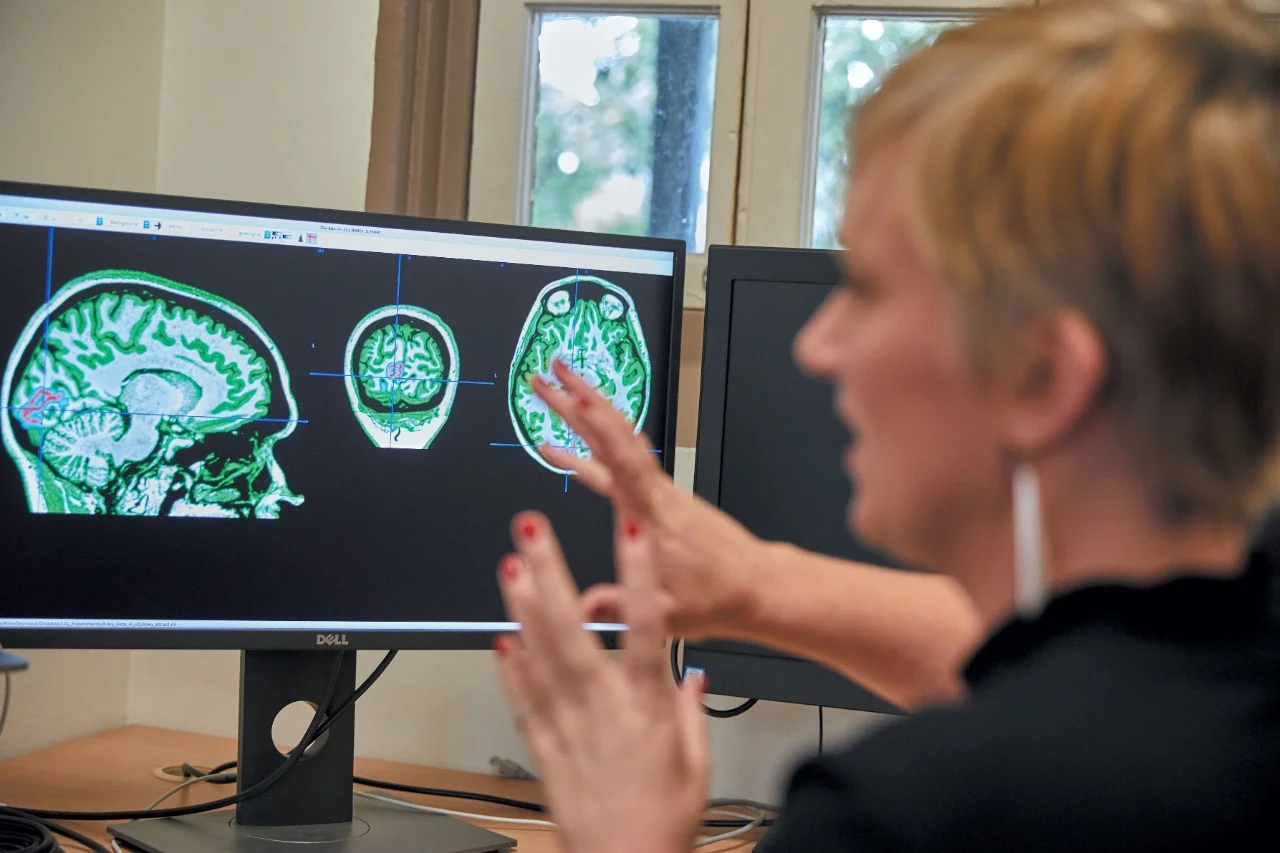Cancer DNA in the Crosshairs
You can search for courses, events, people, and anything else.
“Fundamentally I’m interested in how the brain works,” says Western Sydney University psychologist, Kiley Seymour. “The question I’m investigating now is how the brain manifests consciousness at a physiological level.”
Seymour’s work in this simultaneously philosophical and scientific arena could address long-standing questions around the neurological underpinnings of schizophrenia, and could also have implications for how neuroscience is used as evidence in the courtroom.
The binding problem
Seymour’s curiosity about the workings of the brain was piqued during her undergraduate studies in biology about the physiology of memory and learning. After working in molecular biology and genetics for a few years as a research assistant, she completed a masters in neuroscience at the Max Planck Institute in Germany.
That led to her PhD at the University of Sydney, which explored one of the big mysteries in neuroscience, known as the ‘binding problem’. The binding problem asks how the brain allows us to see the world as a coherent whole when different visual features such as colour, motion, and form are processed in largely segregated brain regions and visual pathways.
“What we know so far about brain processing is that different aspects of a visual image, colour, motion and depth, for example, are processed in separate parts of the brain,” she says. “Yet somehow, our brain effortlessly integrates this information so that we see the world in a very coherent way — the question is how?”
Need to know
- The binding problem asks how the brain perceives visual sensory data as a cohesive picture.
- People with schizophrenia have trouble processing visual sensory data.
- Advanced imaging technology could shed light on this problem.
To find the answer, she combined the latest in magnetic resonance imaging (MRI) technology and machine learning algorithms from the field of artificial intelligence to look for parts of the brain that were sensitive to different conjunctions of colour and motion.
Volunteers were put in an MRI scanner and shown displays consisting of red dots moving left and overlapping with green dots moving right, or green dots moving left paired with red dots moving right. By observing data from their brain, Seymour and her colleagues were able to tell which of these two combinations of colour and motion the subject is actually looking at. “If an area of the brain can discriminate between the two combinations of colour and motion, then it implies that this area contains neurons sensitive to the conjunction of these features.”
From that deceptively simple experimental structure, Seymour was able to overturn previous dogma on the binding problem, and show that instead of colour and motion being processed in separate ‘modules’ in the brain and then combined at a later stage, these features are conjointly represented (bound) very early in the brain’s visual system.
The finding made sense, Seymour says. “Why would the brain segment everything and then bring it back together at a later stage? That operation seems redundant.”
Seymour’s PhD supervisor and long-time mentor, Professor Colin Clifford, from the School of Psychology at UNSW Sydney, says Seymour’s work focuses on a fundamental, basic science question. “We need to understand how the normally-functioning brain works before we can treat deficits or damage to an injured brain,” he says.
Altered perception in schizophrenia
Dr Seymour’s research at Western’s School of Social Sciences and Psychology, the MARCS Institute for Brain, Behaviour and Development, and the Translational Health Research Institute, could shed light on what is going on in the brains of people with schizophrenia. One idea suggests that schizophrenia is the result of a problem in processing sensory information, which might lead to the experience of hallucinations and distorted beliefs or delusions.
“I want to try and understand what’s happening in the brain when patients hallucinate or hold delusional beliefs about the world, for instance the belief that they’re being controlled by another agent,” says Seymour.
To do this, she is working with a cohort of volunteers with schizophrenia who undergo MRI scanning while viewing simple visual stimuli. Seymour is hoping she’ll be able to spot issues with the way sensory information is processed during these tests.
Her work has already generated some interesting results. In a paper published in Neuropsychopharmacology, Seymour and colleagues reported that the brains of people with schizophrenia have problems processing visual sensory data, and that the hallucinations that form part of the illness may represent the brain’s efforts to compensate for that flawed processing.
Seymour likens the idea to someone kept in solitary confinement or in a dark room for long periods. “People in such situations also perceive things that aren’t there. This is because it is a natural process of the brain to try and make sense of deficient sensory information.
There is a truth in the idea that we see what we expect to see.
“Patients with schizophrenia see the world as dimmer and more fragmented in general,” Seymour says. Their hallucinations may result from a tendency to rely more on their beliefs and expectations to interpret the uncertain sensory input.
Our perception of the world is governed by two separate elements of the brain that interact to enable us to see and process visual information correctly. Seymour describes these elements as the bottom-up system, which is where all the sensory input comes in, and the top-down system, which is about perception — what our previous experience tells us we will see, and the context of that incoming information.
“In schizophrenia the top-down stuff is working overtime to deal with a deficient bottom-up sensory input,” she explains.
One of her collaborators in this research is Philipp Sterzer, professor of psychiatry and computational neuroscience at Charité teaching hospital in Berlin. “We are doing this research because we believe that experiments in visual perception offer an exquisite tool to tap into very basic mechanisms of how people make inferences about the world,” he says. “These basic mechanisms of brain function are relevant not only for the perceptual anomalies that [schizophrenia] patients have, but they also allow us to make conclusions about more general mechanisms of brain function.”
In addition to MRI, Seymour is using another scanning technique called magnetic resonance spectroscopy, which can show changes in the brain’s neurochemistry, for example, the levels of different neurotransmitters. This could reveal which neurotransmitters play a part in perception, and how they might be altered in individuals with conditions such as schizophrenia.
But Seymour has her eye on even more advanced imaging technology for her research — the next generation of 7 Tesla MRI machines, which provides the strongest magnetic field yet for research applications. This next-generation machine has functional magnetic resonance imaging (fMRI) resolutions 20 times higher than conventional 7 Tesla scanners. Next-generation 7 Tesla scanners aren’t currently available in Australia, but are available at the University of California, Berkeley, and Seymour is working on a collaboration with researchers there to enable her to scan the brains of individuals with schizophrenia and healthy controls, down to the resolution of a poppy seed.
“Being able to look at the brain on that scale, while people are doing particular tasks, is a real advance for human neuroscience,” she says.
Legal minds
While brain imaging can reliably provide insights into how we process sensory information, people are also considering it as a way to provide information about a person’s guilt or innocence. But given how little researchers really understand the workings of the brain and mind, it’s a fraught proposition. Despite that, neuroscience is already creeping into the courtroom, with lawyers using neurological information about a defendant to argue either for or against culpability.
With her interest in brain and behaviour, one case in particular took Seymour’s interest. It involved a culpability argument based on the absence of protein plaques in an individual’s brain MRI that implied their reasoning couldn’t have been compromised by Alzheimer’s disease.
It was terrible science that should never have been used in the courtroom, she says, but it is symptomatic of an unquestioning appreciation of any kind of scientific evidence, such as DNA evidence, in the law.
Seymour is looking through legal cases in which neurological evidence has been presented to a courtroom, and what the outcomes of those cases were. To do this, she has been collaborating with legal experts at the University of Sydney, UNSW, and Macquarie University, which maintains a database of so-called ‘neurolaw’ cases.
“At this stage, it’s more about finding out how compatible the decisions and legislation are with what we understand about the brain and behaviour,” Seymour says. “The next stage would be to actually educate legal practitioners, which might be the harder part.”
“I’m interested in whether the data that is put before a jury or a judge is presented in a way that properly reflects what we understand about the brain and its effects on behaviour — not whether a crime was committed or not,” explains Seymour.
For example, while anyone over the age of 18 years is tried as an adult, neuroscientific research suggests that the processes of brain development, including aspects such as impulse control, don’t fully taper off until around the age of 25.
There’s a strong philosophical dimension to this question: it drives to the heart of issues such as agency, awareness, and culpability, Clifford says. “If I could argue for example that I shouldn’t be found guilty because my brain was in a particular state, then it gets back to the question of what is me, what am I responsible for?”
It seems there are not enough hours in the day for Seymour to get around to all the issues and subjects she is interested in.
“I don’t want to spread myself too thin,” she says. “It would be possibly better to pick just one thing that I’m interested in and focus on that, but I’ve got interests all over the place.”
Related Articles
Credit
© Cybele Malinowski © Cybele Malinowski © Valentin Amosenkov/iStock/Getty Images Plus © Cybele Malinowski; © Valentin Amosenkov/iStock/Getty Images Plus
Future-Makers is published for Western Sydney University by Nature Research Custom Media, part of Springer Nature.











